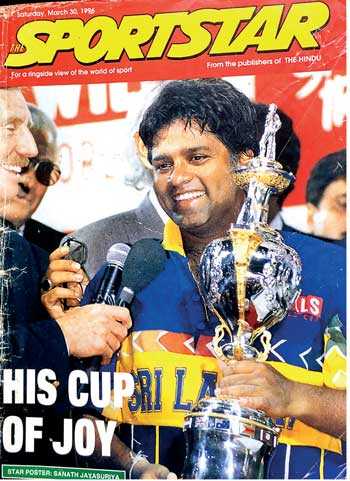Monday Mar 17, 2025
Monday Mar 17, 2025
Saturday, 20 July 2019 00:10 - - {{hitsCtrl.values.hits}}


Another World Cup Cricket tournament – arguably the most popular ODI tournament of the game – ended a few days back. A guy who came to deliver a package to our Perth home when the tournament was on, wanted to know my name for him to note down the receiver of the package.
The moment I told him the name, he said: “Oh, you have the same name as your cricket captain who won the World Cup in Lahore. That was in 1996.”
‘How he remembered all this,’ I wondered. He was definitely an Asian, possibly from Pakistan, in his thirties.
After he left I thought of refreshing my memory of the event we Sri Lankans felt so proud about, and picked the copy of the Sportstar magazine which I remembered carried a feature. The magazine published in India was very popular at the time and we were regular readers. The cover picture of the 30 March 1996 edition featured a smiling Sri Lankan captain being interviewed with the cup (‘His Cup of Joy’) in the hand.
As the Sportstar’s cover story said Sri Lanka (then Ceylon) was ‘On top of the world’ after defeating Australia in the final. Apart from the main article, the magazine also carried a separate ‘box story’ titled ‘Jubilation all over’. It was about how the crowd reacted: “A nation took to the streets after Arjuna Ranatunga and his boys made sure that the World Cup was destined for Colombo, not Canberra. The sight of an embattled country celebrating is somehow more emphatic than celebrating in normal times.
“On the night of the victory, the city had undergone a transformation. Spontaneous celebrations began at almost every street-corner. The Sri Lankan flags were brought out as vehicles began doing the rounds of the city.“The Galle Face, regarded as a kind of a city centre, was the centre of the revelry. Children, adults and even burqa-clad women were at hand to celebrate what is seen here as the ultimate success for Sri Lanka in its sporting history.”
The columnist Amit Baruah referred to the tumultuous reception accorded to the team at the Bandaranaike International Airport which was followed by several stops on route to the city, as people stopped and mobbed their heroes. They first went to Temple Trees and met President Chandrika Kumaratunga and after an hour, to the Cricket Board office.
“One man who had shaved his head, had ‘SRI LANKA’ written across the back of his head. Waving the National Flag furiously, he joined others in patting the players as they went past. Newspapers in the country carried a host of advertisements congratulating the team on their victory. ‘Time stands still. Business is suspended…Wives forgive husbands. Guys forget girls. At every watering hole euphoria overflows. History writes a new chapter in golden letters. Every Sri Lankan wherever in the world he lives is roaring like a lion…We won the World Cup!’ from Union Assurance was a sample of the ads.” In an editorial entitled ‘All Hail the Conquering Heroes’, The Island said: “It was in Australia that the team was forged into a fighting unit. This most controversial tour put fire into the bellies of our cricketers…a resounding slap was delivered to the Aussies and the Windies when the two other South Asian cricketing nations came here, played a match against Sri Lanka and proved that the so-called (security) fears were baseless.”

Discover Kapruka, the leading online shopping platform in Sri Lanka, where you can conveniently send Gifts and Flowers to your loved ones for any event including Valentine ’s Day. Explore a wide range of popular Shopping Categories on Kapruka, including Toys, Groceries, Electronics, Birthday Cakes, Fruits, Chocolates, Flower Bouquets, Clothing, Watches, Lingerie, Gift Sets and Jewellery. Also if you’re interested in selling with Kapruka, Partner Central by Kapruka is the best solution to start with. Moreover, through Kapruka Global Shop, you can also enjoy the convenience of purchasing products from renowned platforms like Amazon and eBay and have them delivered to Sri Lanka.
Discover Kapruka, the leading online shopping platform in Sri Lanka, where you can conveniently send Gifts and Flowers to your loved ones for any event including Valentine ’s Day. Explore a wide range of popular Shopping Categories on Kapruka, including Toys, Groceries, Electronics, Birthday Cakes, Fruits, Chocolates, Flower Bouquets, Clothing, Watches, Lingerie, Gift Sets and Jewellery. Also if you’re interested in selling with Kapruka, Partner Central by Kapruka is the best solution to start with. Moreover, through Kapruka Global Shop, you can also enjoy the convenience of purchasing products from renowned platforms like Amazon and eBay and have them delivered to Sri Lanka.